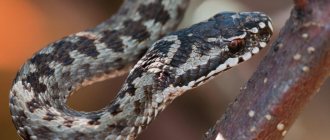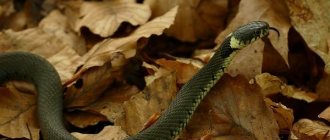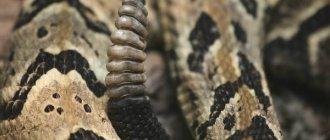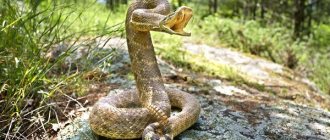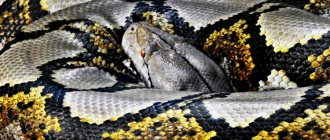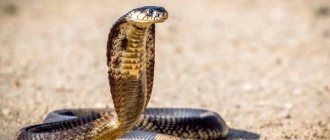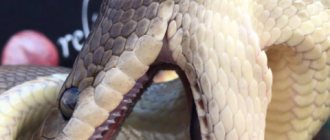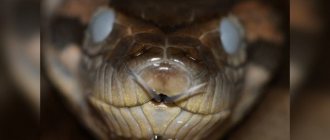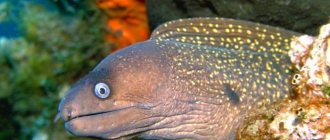Description and features
In Russia, among the variety of other species of poisonous reptiles, one most often comes across the common viper , which, due to its immunity to low temperatures, lives not only in the northern and central parts of Europe, but also on mountain plateaus, in Siberia, on the island. Sakhalin.
Many people have heard about aggressiveness and cases of attacks by reptiles, so people are interested in what a viper and whether it is easy to identify it among other harmless reptiles. The viper in the photo surprises with its variability of appearance.
More often, regardless of the background color of the body (yellow, brown, gray, brown), a dark stripe in the form of a zigzag line is clearly visible along the ridge. There are black vipers, in this case the zigzag is blurred, the tail below is yellow or orange. The weight of the snake is 100–200 g, males grow to -60–80 cm, females are heavier and 10 cm longer.
The head with a rounded muzzle is flattened, triangular, separated from the body by a cervical interception. The frontal, parietal and nasal shields are dark in color. Supraorbital scutes hang over the small brown eyes, giving the muzzle an angry expression.
The slit-like vertical pupils expand with the onset of darkness, filling the entire eye. Thanks to visual acuity, the viper does not remain hungry after a night hunt. The plump body with a short tail, tapering towards the end, is covered with scales.
Two sharp fangs grow in the upper jaw of the snake, to which ducts of glands with poison are connected. At the moment of attack, the jaws open wide, the teeth, which previously lay horizontally with the tip inward, move forward. The muscles located around the fangs contract sharply. A bite occurs with a simultaneous injection of toxins.
The internal organs of the snake are elongated and located asymmetrically one after another. The bone marrow, unlike the brain, is well developed, which determines clear coordination of the reptile’s movements and an instant reaction to changes in the situation.
Vipers, due to the specific structure of the respiratory system, where an additional tracheal lung was formed instead of the atrophied left lung, have the ability to swell when in danger and make loud hissing sounds.
Natural enemies of common vipers
Photo: Common viper from the Red Book
Although the viper is dangerous and poisonous, it has many natural enemies who are not afraid of its poison and are not averse to eating snake meat. Surprisingly, one of the ill-wishers is the common one; he fearlessly enters into battles with the viper, because he is immune to its poison. When fighting, hedgehogs have their own unsurpassed tactics: the prickly one manages to bite the reptile on the body, and then instantly curls into a ball, exposing its sharp spines, which the snake cannot cope with. This is repeated until the viper weakens and dies.
In addition to hedgehogs, among the snake enemies you can see:
- ferrets;
- foxes;
- badgers;
- wild boars (they also have immunity and are not afraid of poison).
Not only animals, but also some birds successfully catch vipers, these are: owls, snake eagles, herons, storks. We should not forget that sometimes the vipers themselves eat each other, suffering from cannibalism.
Nevertheless, the most dangerous and insurmountable enemies for vipers are people who interfere with their snake life, destroying their permanent places of deployment. People catch vipers for terrariums and illegally destroy snakes to collect their venom, which is used in medicine. Based on everything described, you understand that the life of reptiles is not easy and maintaining it is not easy.
Kinds
Scientists have identified 4 subfamilies and about 300 species of vipers. In addition to the common one, the following types of reptiles are the most common and interesting to study:
1. Gyurza. Massive, up to two meters long, the toxicity of the venom of which is slightly less powerful than that of a cobra, is not included in the group of viviparous reptiles. The parameters of male viper are greater than those of females.
Another distinctive feature of the snake is the replacement of small scutes on the head with scales. The color is inconspicuous gray, there is no stripe along the ridge. There are spots on the sides and along the ridge of different shades of brown. The pattern starts from the neck and ends at the tip of the tail. The belly is speckled, lighter than the back.
The Red Book species of vipers, living in the foothills, is found in North Africa and the countries of the Middle East. In Russia, a small population lives in the North Caucasus. Compared to the common viper, the viper is less cautious and often settles close to humans.
2. Nikolsky's viper. Reptiles are common in Ukraine, in the European part of Russia to the Urals. The snake acquires a black body color and a yellow tip of the tail on the reverse side only after 3 years. Young reptiles are brown with a zigzag stripe on the back.
Previously, it was believed that the black viper was a subspecies of the common viper, but after a more detailed study, scientists identified the snake as a separate species. Some zoologists still doubt the correctness of the identification.
Nikolsky's viper grows up to 80 cm, males are smaller than females. The snake swims faster than it moves on land. Hunts in the daytime. In moments of danger, in addition to a vertical stance and a loud hiss, it releases a foul-smelling substance from special glands to scare away the enemy.
3. Rough tree viper. Snakes, colored in various shades of blue, green, yellow, and red, inhabit the tropical and subtropical forests of central and western Africa. Reptiles grow up to 45–80 cm in length.
Life in trees is facilitated by a prehensile tail and ribbed, keeled scales. While hunting, the tree viper disguises itself as a branch, bending at different angles. In addition to rough vipers, spiny bush vipers, horned vipers, green vipers and black-green vipers are also called tree vipers.
4. Steppe viper. The reptile inhabits the southeastern part of Europe, steppes, forest-steppes of the Caucasus, the Black Sea coast, and southern Siberia. The average length of a representative of the species is 60 cm. On the head there is a pattern in the crown area that is darker than the background tone of the body.
The skull is elongated, the muzzle is raised at the edges. Along the ridge of the gray-brown body there is a dark stripe, usually continuous zigzag, sometimes intermittent. The belly is dirty white and speckled. The reptile's venom is slightly toxic.
The steppe viper swims well, moving faster than on the ground through trees. Unlike other species of vipers, the steppe viper's diet is dominated by insects. By destroying large numbers of locusts in cultivated fields, the reptile helps farmers preserve their harvest.
5. Rhinoceros Viper. The upper part of the body of a bright, beautiful reptile is covered with a variety of geometric shapes, painted in 15 shades of red, blue, green, and yellow. The belly is gray with black spots.
The rhinoceros viper got its name because of the two sharp scaly spines growing at the end of its snout, pointing upward. The maximum body length is 1.2 m, the minimum is 0.6 m. This type of viper lives in all parts of Africa except central. Prefers to live near bodies of water, without venturing deep into forests.
People's prejudiced attitude towards the harmless water snake, which is popularly known as the chess viper , is explained by the absence of yellow ears on the head, characteristic of the snake. In fact, the snake found in bodies of water is safe. This fact is confirmed by the round pupils characteristic of non-venomous snakes. In moments of danger, the water snake hisses, secretes an unpleasant-smelling liquid that is difficult to wash off, but does not bite.
Lifestyle and habitat
The viper snake is not a nomadic reptile. Migrates no more than 5 km, choosing a suitable place for hibernation. Starting from the last month of autumn, reptiles look for crevices and burrows that go 2 m underground. At this depth, positive temperatures remain all winter, comfortable for vipers.
With a shortage of wintering areas, the concentration of snakes in one place reaches several hundred individuals. When the food supply is depleted, reptiles move 1–2 km beyond the boundaries of their permanent habitat, an area of no more than 100 m.
In the spring, vipers crawl out of their holes and look for a partner to mate with. Reptiles love to bask in open areas under the sun's rays near their shelter. The rest of the time they hide in secluded places or hunt. The viper does not crawl after prey, but lies in ambush, waiting for the victim to come almost close.
The snake is non-aggressive when nothing threatens it, but in moments of danger it even rushes at stationary inanimate objects. Defenseless, inactive, they tend to crawl into a secluded place of the reptile during molting.
2 weeks before changing the outfit, the skin turns pale and the cornea of the eyes becomes cloudy. Molting occurs in different ways in vipers. If the snake is young, healthy and full of strength, the skin is renewed in a few hours. It takes weakened, sick, old snakes several days to shed.
Vipers are found in different biotopes - in forests, fields, meadows, swampy areas, in rock crevices, on the banks of reservoirs, and even in summer cottages and garden plots. Snakes are excellent swimmers and, if necessary, can cross a river without much effort.
As a result of poachers' deforestation, drainage of swamps, and development of virgin lands, the numbers of some species of reptiles, including the common viper, are listed in the international and regional Red Books.
Natural enemies contribute to population decline. Reptiles feed on wild boars, which are completely immune to poison, foxes, wolves, hedgehogs, badgers, and hedgehogs. Snakes are part of the diet of herons, eagles, eagle owls, and storks.
What does the common viper eat?
Photo: Gray common viper
The viper menu can be called quite varied. For the most part, it absorbs the food that is available in a particular area.
The common viper eats:
- field mice;
- shrew;
- moles;
- small birds (warblers, buntings, pipits) and their chicks;
- various lizards;
- frogs;
- insects
It is young reptiles that often snack on all kinds of insects: locusts, butterflies, beetles, earthworms, slugs, ants.
Interesting fact: Among vipers, such an unpleasant phenomenon as cannibalism sometimes occurs. The female may eat her newborn cubs. This usually occurs due to lack of food.
Regarding nutrition, the common viper can go from one extreme to another. On the one hand, she has a good appetite and is very gluttonous, which allows her to eat two pairs of frogs or mice at once in one sitting. On the other hand, a reptile may not eat for more than six months (from 6 to 9 months), and no particular harm to the body is observed. Such periods of starvation occur in winter, when the viper enters a kind of torpor, slowing down all body processes, feeding on the fat accumulated over the summer season. Another reason for such a long diet is forced, it is due to the scarcity of food supplies in the viper’s territory.
The common viper is an excellent hunter, attacking its potential prey with lightning speed, without any delay. The attack ends with a poisonous bite. After this, there comes a moment of waiting for the death or weakening of the victim, only then the viper begins to eat. Having eaten its fill, it retires to its shelter to digest what it has eaten; this process usually lasts several days. The snake has enough moisture in its food, but sometimes it drinks dew or rainwater.
Nutrition
When obtaining food, the reptile does not catch up with the victim, but attacks from ambush. Hiding in the grass or on a tree, the snake quickly attacks unwary rodents, frogs, and lizards. The common viper eats chicks, adult passerine birds, and loves to feast on eggs.
If the hunt is unsuccessful, the reptile has to be content with insects - cicadas, grasshoppers, large beetles, butterflies. Snakes are not able to chew food, so they swallow their prey whole, creating an open angle from their jaws.
The reptile pulls its upper jaw onto the victim, holding it with its lower teeth. Then he releases his fangs and pushes the other jaw forward. With these movements, the snake pushes its prey into the throat, muscular esophagus.
Reproduction and lifespan
In viviparous female vipers, sexual maturity occurs at five years, in partners - at four. The mating season begins in the spring at stable above-zero temperatures 2-3 weeks after hibernation.
Depending on the region of residence, the timing of mating and the frequency of reproduction differ. In areas with a warm climate, the mating season begins in March, and the female gives birth to cubs annually. In the northern regions, vipers wake up 1–2 months later and reproduce every other year.
First, males crawl out of secluded places of hibernation into sunny open areas. After 10 days, females appear, which male individuals look for in their tracks. If two males become interested in the same snake, a fight occurs between them.
During ritual dances, rivals measure their strength, try to pin each other to the ground, but avoid poisonous bites. The female's genitals are represented by two ovaries, the male's - testes and a pair of sacs with spines located behind the anus.
During coitus, the couple intertwines their bodies; the male, pushing the copulatory organ out from under the skin, penetrates the female’s cloaca. At the end of the process, the reptiles lie motionless for several minutes, then crawl away in the opposite direction and make no further contact.
Pregnancy lasts on average 3 months, but there are exceptions. The male's sperm is stored in the female's body for a long period; fertilization occurs when favorable external conditions occur. There was a case when, when keeping snakes in captivity, newborn snakes appeared 6 years after mating.
The viper does not lay eggs, but carries them in the womb. Some of them resolve, the rest develop safely. Through the blood vessels of the mother's oviducts, through the shell, additional nutrition is supplied to the embryos, which develop mainly due to the yolk.
The female gives birth to 5–10 poisonous children. Childbirth, which lasts up to 4 days, takes place on a tree. The reptile wraps itself around the trunk, swinging its tail, from under which newborns fall to the ground. Small snakes immediately crawl away in different directions, hiding in the thick grass. The parent does not take any part in feeding or raising them.
Snakes are born the size of a pencil or a little larger, with a skin color lighter than that of the mother. After a few hours or days, the first skin change occurs, after which children differ from their parents only in weight and length. Despite the fact that the nutrient reserves are enough for 6 days, the young animals begin hunting insects immediately after molting.
A direct relationship between the lifespan of snakes and their species has been revealed. Small reptiles live 7 years, large ones - 15. Steppe vipers are long-lived, some of them die after 30.
Treatment methods after a snake bite
The effect of viper venom on the human body in most cases ends 2-4 days after the incident. But with severe intoxication, its consequences can be felt even after six months.
The recovery period also depends on the chosen treatment methods for the victim.
In the emergency department, the patient is prescribed a series of tests to assess his general condition and determine clinical and laboratory parameters. The treatment method is determined based on the results:
- general blood test;
- general urinalysis;
- measurements of fibrin degradation products;
- coagulation profile;
- levels of electrolytes, urea, creatinine.
Moderate intoxication requires an ECG, a chest x-ray and a number of additional tests. The patient is regularly monitored for 8 hours after admission. If after this no obvious symptoms of intoxication are recorded, the victim is sent home. This interval is important because the effects of the snake's venom can increase over time.
If there are severe symptoms, the patient is prescribed symptomatic therapy: sedatives for severe nervous excitement, painkillers for pain, vasopressors to eliminate shock. Treatment of a wound from a snake bite is standard, with treatment with antiseptics and regular dressing changes.
Interesting Facts
The most interesting things about vipers:
- if a newborn viper does not have time to hide in the bushes, it can serve as lunch for its parent;
- Snakes shed throughout their existence; cubs molt more often than adults due to their rapid growth;
- The Japanese, Chinese, and Koreans consider viper meat a delicacy and a remedy for healing many diseases;
- a temperature sensor on the snake's head, which helps navigate at night, can detect a difference of 0.002°C;
- reptiles are poisonous immediately after birth;
- snakes release venom when bitten in 75 out of 100 cases;
- the teeth of the African Gaboon viper grow up to 3 cm;
- Malaysians living on the island of Penang revere vipers as a sacred animal;
- steppe vipers move faster in water and in trees than on land;
- Snake aggression increases during the mating season, which occurs between March and June.
The teeth of a viper grow and change throughout its life, both as planned and when lost, this allows the snake to be always armed and ready to attack the victim.
First aid
To moderate the effect of viper venom on the body, doctors recommend providing the victim with first aid as quickly as possible:
- calm him down;
- take it to the shade and lay it down so that the head is lower than the body level - this will reduce the risk of developing cerebrovascular accidents;
- treat the bite area with an antiseptic;
- apply a sterile pressure bandage (but not a tourniquet);
- minimize the load on the bite site, immobilize this area if possible, apply a splint to reduce the drainage of the venom by the lymphatic system;
- provide plenty of drinking to normalize the water-salt balance - tea, coffee, still mineral water.
After the ambulance team arrives, the victim will be given an antidote. A specific serum against viper venom is rarely used; The universal serum “Antigyurza” is more widely used, neutralizing the effect of most snake toxins.
